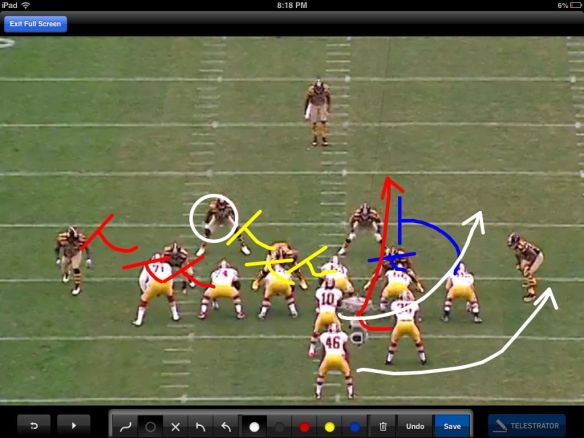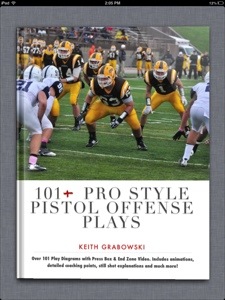Everyone seems to run the bubble, but Coach Brown has done a solid job in creating a thought process for how to attack an alley player in their read game. Having 4 different ways to account for the alley defender, they are able to put a defense in a bind and make them work on a lot of variations of what is really the same play. The key is to make it as simple as possible for the offensive players to execute through their teaching and terminology. Coach Brown shares the concepts and illustrates the variations with video. 32 game video cut-ups are included.
Sample:
History
It’s amazing to me to see all of the interest in the Pistol Offense, and the amount of creativity it has sprung at all levels of football. When I first started working at the University of Nevada in 2006 I had no idea that the seemingly simple alignment change that we made in our offense would take off the way it has. Being in the middle of that expansion has proven to be a tremendous tool in my development as a coach, but I’ve also started to realize that it has caused me to look at attacking a defense in a completely different way.
Throughout my time in Reno, we had countless visitors from all levels of football, and one thing that Coach Ault was great about was getting ideas from those staffs in exchange for opening our doors. As a young Graduate Assistant I was able to clinic with some great offensive staffs from every level of football and from every corner of the country. One of the ideas that we started exploring and was of particular interest to me was the different zone read concepts we kept discussing with Spread staffs who were making the stop through campus. There was a lot of potential there, but we had to find out a way to incorporate it into the Pistol.
One of the biggest misnomers I notice when people ask me about the Pistol Offense is that they tend to almost exclusively relate it to Zone Read schemes and a mobile quarterback. In reality, that element of the offense was really something that evolved with our personnel. One of the biggest advantages of the pistol set is that defenses have to defend both sides of the formations. We do not tip any of our plays by the alignment of our backfield. So to me the most interesting part of our expansion in the offense was figuring out how to incorporate Zone Read schemes into the Pistol Set to keep our philosophy.
During the spring of 2007, we started playing with the mechanics and timing of how to run the Read concept from a Pistol backfield set. We played with a few different actions, alignments, and timing. Since everyone was doing this out of an off-set backfield we had no film to study, and had to work through it ourselves. There was a lot of work put into adjusting our run-timing and the mesh between the QB and RB. Through this trial and error we realized that it would be possible, and now we just needed to commit to it. Once Colin Kaepernick took over as our QB it was very evident that we needed to utilize his physical tools to really stress the defense. That off-season the full commitment to the Pistol version of the zone read took off. Once we had this down, then we also needed to figure out the next step to expand again to stay ahead of the defensive adjustments.
Answers for the Force Defender
One of the first issues we needed to address once we dove into the zone read game was the perimeter blocking element of the play. We were a very efficient team when it came to running the inside zone, and because of this, teams committed a lot of their efforts to stopping the interior run game. A lot of times this simply forced the pull read and their answer was to run linebackers and safeties into a force position to account for the QB. The answer we needed to find was how to protect what we termed the alley. At the time there were three different answers we had to combat this problem. We could send our read side TE to the force player, or we could bring a WR or Wing from the opposite side of the formation to either block the defender or to use as a pitch man creating a triple option type look. These are still the answers that I utilize the most in our offense here at Fort Lewis.
The “Force Block”
The first answer that we had was a simple force block by the TE. This really helped us in two ways. First, it took care of the SS that had been hurting us in the alley. The TE was able to become a perimeter lead blocker for the QB doing a block that he had already been doing on other plays. This also allowed us to read the closed side of the formation and hide our read side even more than the Pistol backfield set already did.
About Dave Brown
Offensive Coordinator Dave Brown joined the Fort Lewis College coaching staff prior to spring practice in 2013 after spending the last seven years coaching at the Division I level, at the University of Nevada and Portland State. During his career, Brown has been on the coaching staffs of teams that appeared in seven bowl games.
While at Nevada from 2006 to 2010, the Wolf Pack ranked at or near the top of the NCAA FBS leaders in rushing offense (first in 2009 and third in 2008) and total offense (second in 2009 and fifth in 2008). Brown coached Colin Kaepernick, who was the 2008 WAC Offensive Player of the Year and the only player in NCAA history to throw for 10,000 yards and rush for 4,000. In 2010, Brown left Nevada to join former colleague Nigel Burton and to assist in installing the pistol offense. At Portland State, he helped the Vikings lead the Big Sky Conference in rushing (203.3 yards per game) in 2010 and improve their total offensive output by 95.7 yards per game over the previous season. In 2011, Coach Brown returned to Nevada during the 2011 and 2012 seasons before joining the Skyhawks.
Brown has 12 years of diverse experience in three different levels of NCAA football, with emphasis on every offensive skill position. Most notable is his experience with the pistol offense, which was actively involved in designing, teaching and adapting at both Nevada and at Portland State.






